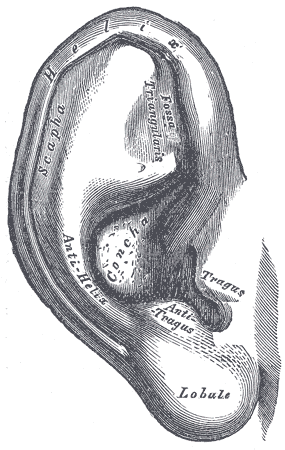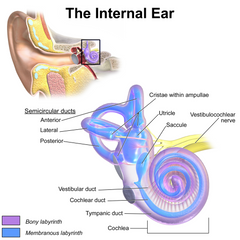
The human ear is a network of auditory channels, membranes and nerves culminating in a complicated and wonderful sensory organ. Working in conjunction with the bilateral primary auditory cortex it converts the transmission of sound waves into sensory data that our brain interprets and extracts usable information from, such as the origin, intensity, and source of the sound, all of which are necessary for communication. It is a biological marvel.
Here at Empire Ears we mostly just blast music into it.
Understanding the intricacies of the ear, however, has informed the construction and tuning of our in-ear monitors to best serve our customers. Knowing the structure of the ear - inside and out, is what makes our universal in-ear monitors - as well as our custom in-ear monitors, fit better than any other on the market.
Earbuds, Earphones - also known as in-ear monitors, and headphones interact with the human ear differently. Headphones typically sit around or on top of the pinna or auricle - the part of the ear that is protruded from the head. Earbuds sit within the pinna in what’s called the concha cavum, typically held in place by the tragus and antitragus protrusions. Earphones/In-ear monitors, however, create a seal within the ear canal, also called the auditory canal and, much to the delight of this author, the external acoustic meatus. This gives them passive ambient noise cancellation qualities that dwarf those of earbuds and rival those of high end headphones. Read more about the differences between them HERE.
Outer Ear / Pinna / Auricle
The purpose of the shape of the human ear is to direct sound into the ear canal. This dramatically increases the efficiency of our hearing as well as the apparent volume of what we’re hearing.

- Helix
- Helical Crus
- Scaphoid fossa/scaphoid - The depression between the Helix and the Antihelix
- Antihelix
- Superior and Inferior Crus - The branching “y” of the antihelix
- Fossa triangularis - The depression between the superior and inferior crus of the antihelix.
- Tragus
- Antitragus
- Concha cavum and cymba - the main cavity of the ear, separated by the Helix Crus
- Ear Canal / Auditory Canal / Exterior Acoustic Meatus
Middle Ear
 Lying between the inner ear and outer ear, the middle ear consists primarily of the tympanic cavity, and air filled cavity holding the three ossicles - the bones responsible for transmitting the sound from the eardrum to the inner ear. The Malleus bone transmits sound to the incus bone, in turn transmitting sound to the stapes bone, who delivers the vibrations to the oval window, a secondary tympanic membrane that transmits the vibrations to the liquid filled cochlea. The round window separates the tympanic cavity from the scala tympani - part of the inner ear’s cochlear duct - and serves as a pressure equalizer to the vibrations transmitted via the stapes bone. The primary function of the middle ear is this transmission of vibrations from the exterior ear to the interior ear.
Lying between the inner ear and outer ear, the middle ear consists primarily of the tympanic cavity, and air filled cavity holding the three ossicles - the bones responsible for transmitting the sound from the eardrum to the inner ear. The Malleus bone transmits sound to the incus bone, in turn transmitting sound to the stapes bone, who delivers the vibrations to the oval window, a secondary tympanic membrane that transmits the vibrations to the liquid filled cochlea. The round window separates the tympanic cavity from the scala tympani - part of the inner ear’s cochlear duct - and serves as a pressure equalizer to the vibrations transmitted via the stapes bone. The primary function of the middle ear is this transmission of vibrations from the exterior ear to the interior ear.
Inner Ear
Sitting in the temporal bone, the inner ear contains the vestibulocochlear organs, consisting of the complicated structures of the Bony Labyrinth and, within that, the Membranous Labyrinth. The bony labyrinth is comprised of the cochlea, vestibule and the three semicircular canals.
-
 Cochlea - Housing the cochlear duct - the key auditory component of the inner ear - the cochlea is a cone shaped spiral. The two perilymph filled chambers of the coclear duct, the scala vestibuli and the scala tympani are held in place by the bony scaffolding of the cochlea
Cochlea - Housing the cochlear duct - the key auditory component of the inner ear - the cochlea is a cone shaped spiral. The two perilymph filled chambers of the coclear duct, the scala vestibuli and the scala tympani are held in place by the bony scaffolding of the cochlea - Vestibule - Separated from the middle ear via the oval window, the vestibule is the central part of the bony labyrinth. The vestibule is connected to the to the front and at the rear, the semicircular canals. Within the vestibule lie the saccule and the utricle.
- Semicircular Canals - The semicircular canals consist of the posterior, lateral, and anterior canals, containing the semicircular ducts. These are responsible for our sense of balance in conjunction with the saccule and the utricle. Sensory receptors within the ducts detect changes within the flow of the contained endolymph due to changes in direction or speed of our head and send signals to the brain which processes the change and allows for preservation of balance.
We design our in-ear monitors to take advantage of the human ear’s natural structures and features in order to deliver the most pristine and impactful sound possible. The benefits to audiophiles become readily apparent the minute they wear our monitors. Used in tandem with a high quality DAC and media player the quality of music delivered by the Empire Ears in-ear monitor system is unparalleled in terms of quality and comfort. When used professionally, nothing touches a personal monitor on stage or in production. The lack of a wedge monitor interfering with the audience mix keeps the performance mix sounding unmuddled and professional. That you can monitor in stereo while performing means that you can build and auditory stage similar to the real stage on which you’re performing, providing you with a real sense of depth and accuracy to you and your band’s sound.
If you’re a vocalist and you want to experience the amazing sound that our in-ear monitors can provide you with you need to check out our EVR unit - specifically designed for performing vocalists this IEM will give you the necessary feedback and clarity to take you performance to the next level! Read more HERE.

 Cochlea -
Cochlea - 